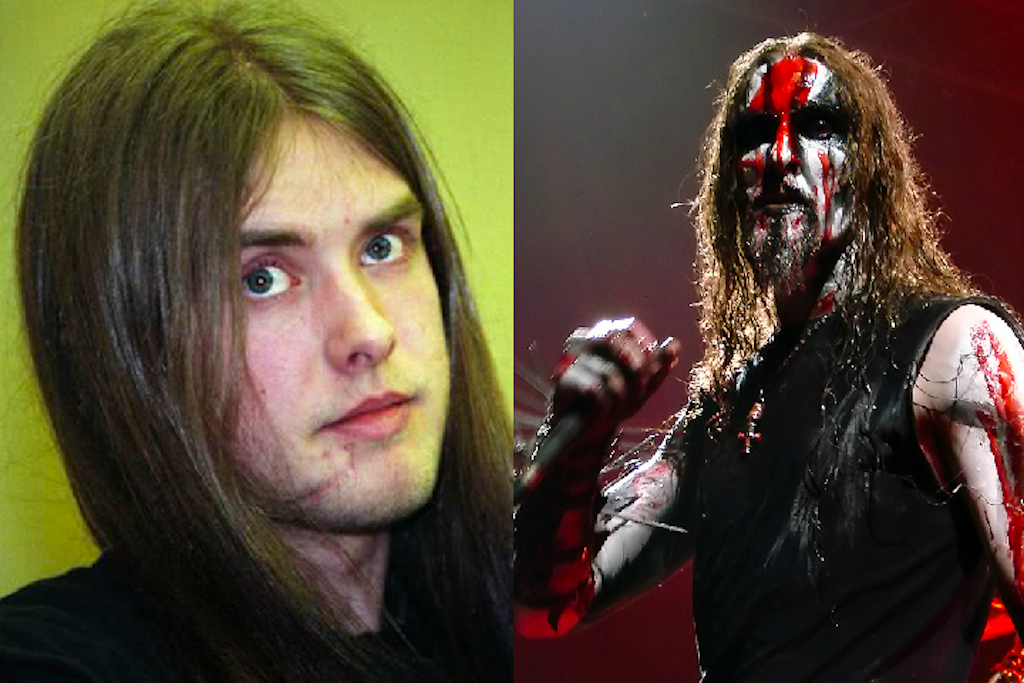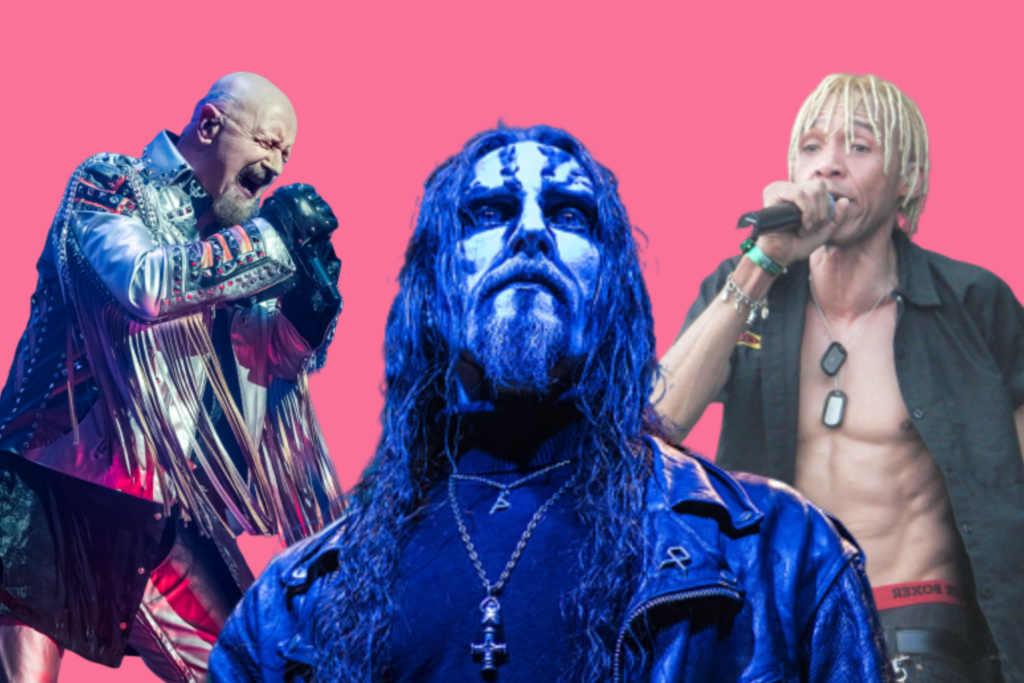The Dark And Downright Terrifying History Of European Death Metal
The story of European death metal is a violent and disturbing one.

The history of metal is steeped in violent lore; myths of destruction, evil, and satanic rituals. But for the most part, those stories are just that — stories.
Ozzy Osbourne isn’t some demonic, hateful cult leader. He’s a gently-spoken British reality TV star who has done a few too many drugs. Alice Cooper isn’t a grand guignol villain. He’s a middle-class American man who watched a lot of horror movies.
But if there’s one sub-category of metal that bucks that trend, it’s the death metal coming out of Europe, particularly the Nordic area. European death metal is the real deal, if by ‘real deal’ you mean a mess of murders, church-burnings and live crucifixions.
It’s not just about the violent trimmings, either — the music from the area is as fiery, inventive, and overwhelming as metal gets. European death metal artists do everything for real, whether it be real-life horror, or their blackened, unforgiving albums.
Here then is a deep dive into the genre, focusing on five of the musicians who made it what it is.
— Content warning: This article contains discussion of suicide, self-harm, and assault. —
Origins: Mercyful Fate
Black Sabbath’s self-titled debut record is the origin point of all modern metal, a work of lopsided genius that synthesised the sonic exploration of Hawkwind and made it heavier, louder and meaner. Few records can truly be said to have changed the state of a genre, but Black Sabbath is one of them — it’s the burned-down grounds from which bands like Venom and Slayer sprung like new shoots.
Indeed, so loud was the impact of Black Sabbath’s debut, and the bands that followed in its wake, that it was heard all the way over in Denmark, where a slew of copycat groups popped up. But none were quite as unique or as innovative as Mercyful Fate.
Led by King Diamond, the one-time singer of a small punk band, Mercyful Fate set the template for baroque, overblown metal. Clad in white and black face paint, his voice thick and arch, King Diamond was the prototypical metal frontman — equal parts entertaining and terrifying.
Sadly, Mercyful Fate were not long for this world. Initially active for a mere four years, the band dropped two all-time great metal albums, Melissa and Don’t Break The Oath, and then disappeared. But the template had already been set. Metal would never be the same.
Onstage Violence: Mayhem
If Mercyful Fate established the visual language of European metal, steeped in horror and occult imagery, then mid-eighties Norwegian act Mayhem pushed that language as far as it would go. Led by a charismatic frontman named Dead — real name Per Yngve Ohlin — the group honed their skills by covering Black Sabbath songs, before moving on to record a string of blackened singles.
But if the music the group released was punishing, their live shows were on another level. Dead quickly became famous for self-mutilating onstage, surrounded by disembodied animal heads on pikes. By all accounts, this violent aspect of his character was not simply for show.
According to his fellow metal singer Stian Johannsen, Dead’s fixation on blood and horror was a product of a deeper sense of alienation. “He didn’t see himself as human; he saw himself as a creature from another world,” Johannsen has said.
Mayhem
Live in Turkey 1990
With Euronymous & Dead in front stage.#Mayhem #90s #BlackMetal #Norway pic.twitter.com/XbIAwjx4h0— ♆ Black Antiquarium♆ (@blackmetalpics) May 24, 2020
Slowly, Dead’s obsession with pain grew more consuming — according to rumours at the time, he stabbed Mayhem’s lead guitarist Euronymous during a fight while they were at work on their debut album. Shortly thereafter, Dead committed suicide.
Upon discovering the body, Euronymous waited a while before calling emergency services: first, he purchased a disposable camera and took a number of photographs of the bloody scene; then, he took some of Dead’s skull, and fashioned it into necklaces for other European metal artists to wear. Controversially, one of the images Euronymous snapped of the body was used for the front cover of a Mayhem live album.
After Dead’s passing, Mayhem finally released their debut studio album, and continued to tour with a rotating cast of replacement singers. Yet the band would never again push the boundary quite so far — thankfully.
The Allure of The Baroque: Emperor
For many years after Mercyful Fate, European metal repeated the same direct, compact song structure that the band had made famous. But by the early nineties, things began to change. And no band better demonstrated that revolution that Emperor.
Active for ten years, from 1991 to 2001, the group released one of the true masterpieces of metal: In the Nightside Eclipse. Big, loud and operatic, the record pioneered long song structures and complex, interlocked time signatures. The genre would never be the same.
But Emperor were not free from the violence and crime that had begun to define the scene. The band’s drummer, Faust, murdered a man who he later claimed had propositioned him one night in 1992, stabbing the victim to death. It would be two years before he was held to account for his crime. Not long afterwards, the band’s drummer, Samoth, was found guilty of burning down a church, a practice that had begun to grow in popularity across the metal scene.
Slowly, the subculture was sinking further into anti-social behaviour. But the worst was yet to come.
More Murder: Burzum
In 1991, musician Varg Vikernes launched the one-man metal act Burzum. Taking the band name from the word for ‘darkness’ in a fictional language known as “black speech”, designed by J.R.R Tolkien, Vikernes had a distinct and often terrifying vision. His first record, a self-titled collection of swirling black metal songs, swapped between ashy soundscapes and long, complex ballads. Nobody else sounded quite like him.
Like many of his colleagues, Vikernes was present for a string of church burnings — he later claimed that he was involved only as a spectator, rather than an instigator. Frequently spotted with Mayhem’s Euronymous and Emperor’s Faust, he was fixated by death and chaos.
That fixation came to a head in 1993, when Vikernes stabbed Euronymous to death. According to Vikernes, the act was one of self-defence — unlike other musicians of the time, he took no credit for the violent act. But his pleas fell on deaf ears, and he was sentenced to over two decades in prison.
Something important that must be remembered:
Sonny Moore in Burzum merch pic.twitter.com/uLe7t0tU4u
— ☿ 𝕭𝖎𝖙𝖈𝖍𝕶𝖎𝖓𝖌 ☿ (@PainxPiss) May 12, 2020
During that incarceration, Vikernes continued to double-down on his morbid and hateful fixations. He started a blog and a neo-Nazi movement, openly calling himself a fascist and propagating hateful rhetoric about both Muslims and Jews.
Since his release from jail in 2009, Vikernes has continued to release music under the Burzum moniker, and to spew hate, advocating for a return to a feudal and pagan European society. Just this year, Vikernes released a new Burzum project, Thulêan Mysteries, culled from recordings over a five-year period.
Progress? Maybe: Gorgoroth
The murder of Euronymous was something of a wake-up call to the European metal scene. Finally, musicians appeared to realise that things had been taken too far, and over the next few years the scene quietened somewhat. And not just quietened — changed. And no act represented that change better than Gorgoroth.
Formed by guitarist Infernus, a Satanist and occultist, Gorgoroth had all of the hallmarks of the bands that had gone before them — stories of hate, horror and evil; long, ashy-white songs; and a tendency to indulge in onstage theatrics. In 2004, for instance, the group staged a show in Krakow that featured eighty litres of sheep’s blood and the mock crucifixion of a number of scantily-clad models, imagery so shocking that they were investigated under Polish anti-blasphemy laws.
But along with all this old-school rabble-rousing, Gorgoroth also waved something of a progressive streak into their work. Gaahl, the band’s lead singer, is openly gay, and his version of anti-Christian rhetoric is distinct from the shocking for the sake of shocking church-burning that came from before him.
“I am opposed to everything that denies the individual to grow, so for me Satan is natural in that matter,” Gaahl has said of his beliefs. “It is about not [being] oppressed by any law such as the church, which is only a way to control the masses.”
Which is not to say that he is entirely without his controversies: he has been accused, for instance, of beating a man and threatening to make him drink his own blood.
But even despite such incidents, the scene truly is changing — albeit in its own, strange, lopsided way.
The Future: Ghost
Over the last decade or so, European death metal has slowly made some kind of move back towards the mainstream. That’s not to say that the genre has become totally normalised, of course, and many of its heroes are still antic gamechangers with provocative album covers and violent lyrics. It’s that murders, crucifixions, and necklaces made out of skull matter have slowly become a thing of the past.
The clearest indication of that change? The success of Ghost.
A massive Swedish metal act that combine the genre’s excesses with the linear, direct songwriting of rock, the band are a true crossover success. That’s even more impressive when you consider what they look like — a gaggle of facepainted, robe-wearing Satanic priests.
They’re not “normal” by any metric. But they are an indication of the genre’s new, mainstream appeal. Stripped of its most alienating trimmings, but still true to the facepaint and brutalism that made the genre famous, European metal is enjoying something of a commercial resurgence.
And what other genre can you say that about — a way of making music that has moved through obscurity, pain and suffering, and come out changed on the other side?
Joseph Earp is a longtime metalhead and staff writer at Junkee. He tweets @Joseph_O_Earp.
